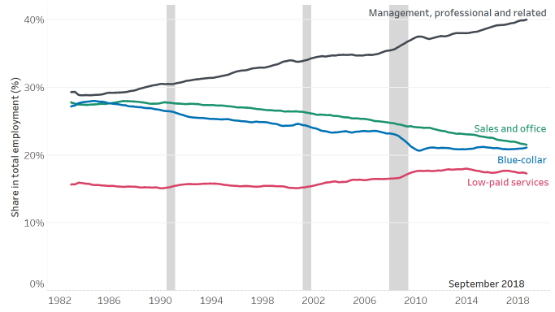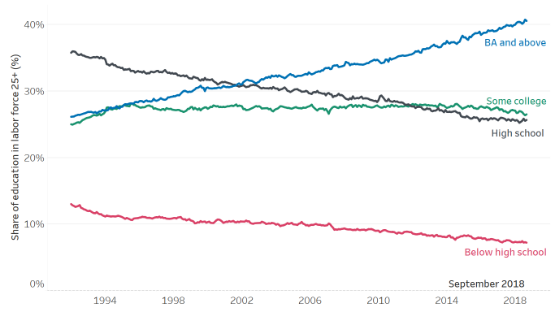Why are labor markets for blue-collar workers tighter than for white-collar ones?
16 Oct. 2018 | Comments (0)
In a recent blog, we discussed our view of a tighter labor market for blue-collar workers than for white-collar workers. In this blog, we elaborate on the reasons, stemming from a shrinking supply of workers interested in blue-collar jobs, but a growing demand for blue-collar workers.
Let’s start with the growing demand.
Somewhat surprisingly, blue-collar and low-paying services occupations’ share in total employment has remained roughly constant since 2010, with the number of jobs in these occupations growing at the same rate as total employment. This is partly due to the resilience of certain occupations that were expected to rapidly decline. The slowdown in the pace at which jobs are being replaced by technology, and the significant decline in offshoring activity, is supporting solid growth in blue-collar and low-paying services employment.
From 2010 to 2018 employment in production occupations grew by seven percent. Farming, fishing, and forestry occupations grew by 17 percent, after having declined continuously in the previous decade. Food preparation and serving related occupations, a sector highly expected to lose many jobs to automation, grew by eight percent during this period. Additionally, construction and extraction occupations, transportation and material moving occupations, and personal care and service occupations have all grown rapidly from 2010 to 2018.
Chart 1: Share in total employment by occupation group.

Note: Blue collar occupations include construction, extraction, farming, installation, maintenance, repair, production, transportation, and material moving. Low-pay services include occupations such as healthcare support, protective service, food preparation and serving, building and grounds cleaning, and personal care and service occupations.
Source: U.S. Bureau of Labor Statistics and Haver Analytics.
If the supply of workers interested in working in blue-collar jobs was growing as rapidly as demand, we would not have a problem. But in reality, the supply of workers for blue-collar jobs has been shrinking. People with a college degree are very unlikely to end up working in a blue-collar job, partly due to the stigma attached to manual labor. This is especially true in a tight labor market like the one the US is currently experiencing. The number of people in the labor force without a college degree could be used as a rough proxy of potential labor supply for blue-collar jobs. But as shown in the previous blog, this group of workers has been shrinking in recent years and will likely shrink even more rapidly in the coming decade.
Why is the supply of workers interested in blue-collar jobs shrinking?
The share of Americans looking for blue-collar jobs is shrinking as they become more educated.
The US working-age population has gotten more educated over time, with the share of the working-age population with no college degree declining significantly. Also, in recent years, an unusually large share of workers in blue-collar occupations have been retiring. This combination of many retirements and few new entrants is significantly reducing the supply of workers for blue-collar occupations. Since 2012, the number and share of people without a college degree has been shrinking. People with a college degree are much less likely to look for a blue-collar job.
Chart 2: Shares of education groups in the 25-64 population.

Note: 2018 represents the last 12 available months — September 2017 to August 2018
Source: The Conference Board using microdata from the Current Population Survey.
Less educated Americans are much more likely not to be in the labor force due to disability.
The increasing share of more educated people in the US labor force is not just because the US population is becoming more educated. It is also because more non-college graduates are leaving the labor force due to disability. The increase in disability rates, partly because of the opioid epidemic, are much more concentrated in the population without a college degree and is therefore having a larger impact on the supply of workers to blue-collar and low-paid service occupations.
Chart 3: Disability share for ages 25-64 by educational attainment.

Note: 2018 represents the last 12 available months — September 2017 to August 2018
Source: The Conference Board using microdata from the Current Population Survey.
The combination of the US population becoming more educated and the concentration of disability among less educated people is significantly reducing the share of less educated people in the labor force.
Chart 4: Shares in the labor force ages 25+ by education groups.

Source: U.S. Bureau of Labor Statistics and Haver Analytics.
There may be other reasons for the shrinking supply of blue-collar workers:
Changes to immigration policy.
Recent immigration policy, which presumably is reducing the number of available undocumented immigrant workers, is having a larger impact on blue-collar occupations than white-collar ones. In a study by The Conference Board from 2016, we find that almost all occupations with a high estimated share of undocumented workers are within the blue-collar or low-paid service jobs. Undocumented immigrants tend to concentrate in construction, agriculture, production (especially in clothing and textile), food preparation and service, and cleaning related occupations.
Concerns about future automation.
When deciding on a career, new entrants to the labor market may shy away from choosing occupations where automation is likely to eliminate a large number of jobs in the future. For example, the predictions of the arrival of driverless cars and trucks may reduce the interest of young people in becoming truck drivers.
The labor shortages in blue-collar jobs are unlikely to disappear any time soon. In fact, they may get worse before they get better. In our next blog we’ll discuss our thoughts about the trajectory of labor market conditions for blue-collar jobs in the next year and next decade. In addition, we have a special webcast coming up in which we give more details on our findings.
-
About the Author:Gad Levanon, PhD
The following is a biography of former employee/consultant Gad Levanon is the former Vice President, Labor Markets, and founder of the Labor Market Institute. He led the Help Wanted OnLine©…
-
About the Author:Frank Steemers
The following is a bio or a former employee/consultant Frank Steemers is a Senior Economist at The Conference Board where he analyzes labor markets in the US and other mature economies. Based in New …


0 Comment Comment Policy